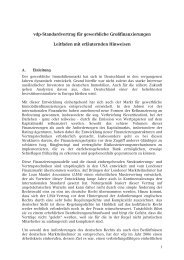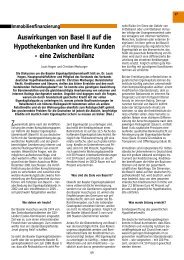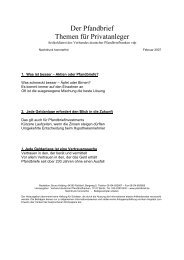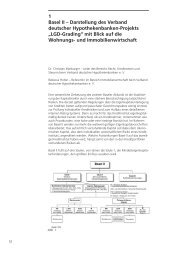Expected Loss Covered Bond Model
Expected Loss Covered Bond Model
Expected Loss Covered Bond Model
You also want an ePaper? Increase the reach of your titles
YUMPU automatically turns print PDFs into web optimized ePapers that Google loves.
APPENDIX E2: MARKET RISKS – MOODY’S EL MODEL’S ANALYSIS OF HEDGING<br />
ARRANGEMENTS<br />
Moody’s EL <strong>Model</strong> will analyse the market risks that may arise between the <strong>Covered</strong> <strong>Bond</strong>s and the Cover Pool<br />
following Issuer Default. Consideration will be given under Moody’s EL <strong>Model</strong> to which of the following market riskrelated<br />
scenarios may arise after Issuer Default:<br />
• Structured finance-compliant arrangements are in place to cover all relevant market risks. The meaning of<br />
the expression “structured finance-compliant arrangements” will include the following requirements,<br />
amongst others:<br />
• Hedging arrangements are designed to survive Issuer Default (reasons for this requirement are described<br />
in the next following paragraph).<br />
• Moody’s swap-related criteria will be fulfilled in all respects for all hedging arrangements. 13<br />
• Arrangements are in place to cover market risks, though these do not comply with all requirements of<br />
structured finance-compliant arrangements in one or more respects. These hedging arrangements do,<br />
however, survive Issuer Default.<br />
• No suitable arrangements in place, or if there are arrangements in place, these will terminate on Issuer<br />
Default.<br />
Under Moody’s EL <strong>Model</strong>, any market risk not covered by arrangements that are designed to survive Issuer Default<br />
may negatively affect the <strong>Covered</strong> <strong>Bond</strong>s. Reasons for this approach include the following considerations, amongst<br />
others:<br />
• An administrator will be assumed to be appointed to manage the Cover Pool following Issuer Default.<br />
• However, it is Moody’s view that an administrator may experience difficulty in trying to cover market risks<br />
following Issuer Default. 14<br />
Under Moody’s EL <strong>Model</strong>, account may be taken of any legislation- or contractual-specific features that mitigate<br />
any of the above considerations as well as any other market risks taken into account.<br />
The remainder of the appendices which describe market risks focus attention on stresses that are applied by<br />
Moody’s EL <strong>Model</strong> in the event that hedging arrangements do not constitute structured finance-compliant<br />
arrangements.<br />
13<br />
See Swaps in European Term Securitisations, May 2002 and Impact of Swap Counterparty Risks on Global Structured Finance Transactions<br />
Moody’s Revised Methodology - Call for Comments, March 2005.<br />
14<br />
In support of its view, Moody’s expects that, in considering entering into hedging arrangements with an administrator, a hedge counterparty<br />
may require collateralisation of the arrangements. This may include frequent posting of collateral, dependent on the evolution of the exposure.<br />
An administrator may not always be permitted following Issuer Default to enter into additional or replacement hedging arrangements.<br />
Furthermore, if entering into hedging arrangements is permitted, an administrator may either additionally not be permitted to provide<br />
collateralisation to hedge counterparties, or have sufficient funds available for this purpose.<br />
European <strong>Covered</strong> <strong>Bond</strong> Rating Methodology Moody’s Investors Service • 21

















